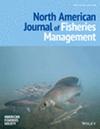鱼藤酮在蒙大拿州博尔德溪西坡切喉鳟鱼恢复中的一次性应用效果
IF 1.4
4区 农林科学
Q3 FISHERIES
引用次数: 0
摘要
尽管杀鱼剂是本地鱼类管理的重要工具,但我们对处理后(即假定的空闲栖息地)本地鱼类种群动态的理解是有限的。在这里,我们描述了下博尔德湖和博尔德溪(蒙大拿州)克氏切割鳟鱼的大小和丰度的长期趋势。在博尔德溪用鱼藤酮处理前后,在平均长度和种群密度方面没有发现显著差异。来自博尔德湖和博尔德河上游的处理后基因样本完全由用于驱回种群的西坡Cuthroat鳟鱼——克氏Oncorhynchus clarkii lewisi组成。博尔德河中下游的基因样本中含有99.4%和98.4%的Westslope Cuthroat鳟鱼,这表明一些非本地鱼类(黄石Cuthroat-Trout Oncorhynchus clarkii bouvieri杂交)在处理中幸存下来。人口统计数据显示治疗后恢复良好;然而,遗传结果揭示了一次性处理的局限性,即不完全的鱼类捕杀。我们证明,从长远来看,在鱼藤酮处理后,Cuthroat鳟鱼种群可以恢复,但在大型排水沟上进行一次鱼藤酮治疗往往无法完全根除种群。因此,管理者应该计划多种处理方法,并利用环境DNA来帮助实现目标物种的彻底清除。本文章由计算机程序翻译,如有差异,请以英文原文为准。
Efficacy of one‐time rotenone application for Westslope Cutthroat Trout restoration in Boulder Creek, Montana
Although piscicides are an important tool for native fish management, our understanding of native fish population dynamics posttreatment (i.e., in putatively vacant habitat) is limited.Here, we describe long‐term trends in size and abundance of Cutthroat Trout Oncorhynchus clarkii in Lower Boulder Lake and Boulder Creek (Montana).No significant differences were found before and after treatment with rotenone in mean length and population density in Boulder Creek. Posttreatment genetic samples from Boulder Lake and upper Boulder Creek consisted entirely of the Westslope Cutthroat Trout Oncorhynchus clarkii lewisi used to refound the population. Middle and lower Boulder Creek genetic samples contained 99.4% and 98.4% Westslope Cutthroat Trout, indicating that some nonnative (Yellowstone Cutthroat Trout Oncorhynchus clarkii bouvieri hybrid) fish survived the treatment. Population demographics showed robust recovery posttreatment; however, genetic results revealed the limitations of a one‐time treatment—that is, an incomplete fish kill.We demonstrate that Cutthroat Trout populations achieve recovery after rotenone treatment in the long term, but one‐time rotenone treatments on large drainages often fail to totally eradicate populations. Therefore, managers should plan on multiple treatments and utilize environmental DNA to help achieve total removal of target species.
求助全文
通过发布文献求助,成功后即可免费获取论文全文。
去求助
来源期刊
CiteScore
2.60
自引率
18.20%
发文量
118
审稿时长
2 months
期刊介绍:
The North American Journal of Fisheries Management promotes communication among fishery managers with an emphasis on North America, and addresses the maintenance, enhancement, and allocation of fisheries resources. It chronicles the development of practical monitoring and management programs for finfish and exploitable shellfish in marine and freshwater environments.
Contributions relate to the management of fish populations, habitats, and users to protect and enhance fish and fishery resources for societal benefits. Case histories of successes, failures, and effects of fisheries programs help convey practical management experience to others.

 求助内容:
求助内容: 应助结果提醒方式:
应助结果提醒方式:


